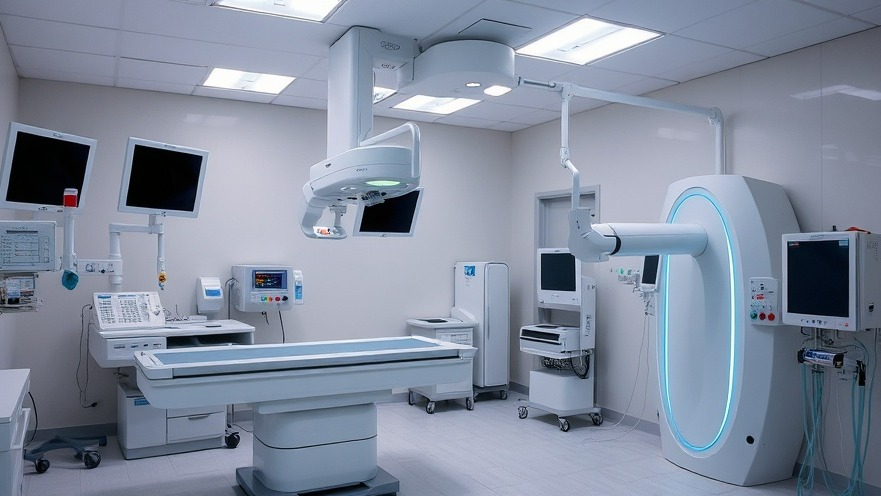
Revolutionizing Medical Imaging: The Future of AI in Healthcare
In a landmark announcement at GTC 2025, GE HealthCare and NVIDIA have unveiled their ambitious plan to reshape the landscape of diagnostic imaging through the integration of autonomous technologies. This quest begins with enhancements to X-ray and ultrasound systems, aiming to not only improve accuracy but also alleviate the growing burden on healthcare professionals. As the demand for efficient diagnostic solutions surges, particularly amidst significant staffing shortages, the collaboration between these two industry leaders promises significant upgrades in medical imaging capabilities.
Strengthening Collaboration: A Legacy of Innovation
The partnership between GE HealthCare and NVIDIA isn't merely a fleeting initiative but a continuation of over 16 years of collaboration focused on medical imaging innovations. An exemplary output of this partnership is the SonoSAMTrack, GE’s pioneering model trained on roughly 200,000 image-mask pairs, which has showcased remarkable segmentation accuracy in ultrasound imaging.
Now, by harnessing NVIDIA’s Isaac for Healthcare platform, GE HealthCare aims to develop autonomous systems grounded in physical AI. This approach ensures that X-ray and ultrasound technologies are not only smart but also practically applicable in real-world scenarios.
Why Autonomous Imaging Matters: An Insight into Current Healthcare Challenges
Medical imaging remains a cornerstone of modern healthcare, with X-ray and ultrasound being the most frequently utilized methods globally. However, the increasing volume of exams — approximately 4.2 billion annually — coupled with radical staff shortages in radiology, has created an urgent need for innovation. According to reports, up to 90% of sonographers experience work-related musculoskeletal disorders due to repetitive motions, revealing a pressing requirement for more efficient practices.
The integration of AI-driven autonomous imaging systems tackles these challenges head-on, allowing healthcare professionals to spend more time on complex cases and direct patient care, while minimizing the physical strain associated with their roles.
Unlocking Greater Efficiency: How AI and Robotics Are Changing Workflows
GE HealthCare’s focus on AI-enabled X-ray and ultrasound systems illustrates a transformative shift in workflow management in healthcare settings. By implementing tools that can capture and interpret medical images autonomously, technicians and radiologists are liberated from time-consuming tasks, ultimately leading to quicker diagnoses and enhanced patient care.
The NVIDIA Isaac platform will facilitate virtual training, simulating various patient and imaging scenarios, thereby optimizing the development process before real-world application. This means a faster rollout of reliable imaging systems without compromising accuracy.
Looking Towards the Future: Potential Impact on Patient Care
The outcome of this collaboration could expand access to medical imaging, particularly in underserved regions where healthcare services are limited. Autonomous systems have the potential to level the playing field, making advanced imaging techniques available to a broader audience.
As GE HealthCare's CEO, Roland Rott states, their commitment to innovative solutions is unwavering — aiming to enhance efficiency while addressing critical staffing shortages that impact patient care quality. Such advancements could redefine what patients expect from healthcare, placing improved diagnostics at the forefront of care provision.
Ready to Embrace Technology? Steps to Integrate AI in Your Practice
For concierge health practitioners on the brink of adopting these exciting technologies, the journey starts now. Educating yourself about the available solutions, exploring partnerships with technology providers like GE HealthCare and NVIDIA, and gradually integrating AI-driven systems into workflows can yield transformative benefits for your practice.
Consider investing in training and education to ensure your staff is adequately equipped to leverage these advancements. Remember, the shift toward autonomy in medical imaging is not just about technology—it’s about elevating the quality of patient care you provide.
By staying ahead of these trends and taking action now, you can ensure that your practice remains competitive and responsive to the needs of your community.
 Add Row
Add Row  Add
Add 






Write A Comment